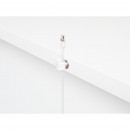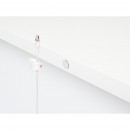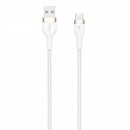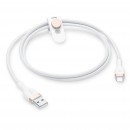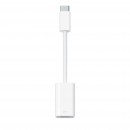I never expected a small change like a new port to cause so much confusion in the Apple user base, but the debut of the iPhone 15 proved me wrong, making CarPlay a huge mess for customers of the latest-generation smartphone.
iPhone 15 no longer comes with Apple's proprietary port known as Lightning but with USB-C, the same port already available on the majority of Android devices, tablets, headphones, and speakers.
USB-C is a widely adopted connectivity option, and Apple adopted it at the request of the European Union. Starting in 2024, device makers selling smartphones and tablets on the continent must fit their devices with USB-C. As a result, the Cupertino-based iPhone maker had no choice but to replace Lightning with USB-C to comply with EU's regulations.
The EU believes that all device makers using USB-C allow for a significant drop in electronic waste while making it more convenient for users to charge their devices because they can use the same cable.
And yet, this approach seems to make charging and using certain iPhone 15 features a major challenge. Some USB-C cables are charging-only, so you can't use them to run CarPlay. Many users weren't aware that only high-speed USB-C cables support data transfers and CarPlay, so they ended up complaining of broken connectivity with a device that cost around $1,000.
Apple tried to resolve the problem in two ways: an adapter and a third-party cable it started selling in its stores.
While the Belkin BoostCharge Pro Flex USB-A to USB-C cable is the most convenient way to deal with the transition to USB-C in a car, especially if the vehicle comes with a USB-A port to run CarPlay, many people decided to use the first option.
The USB-C to Lightning port adapter allows users to continue using the Lightning cable they already have with a new iPhone 15 fitted with the USB-C port.
The USB-C end must be plugged into the iPhone, while the Lightning port allows users to connect the old cable used with an iPhone 14 or a previous model. Depending on the manufacturing year, your Lightning cable could sport either USB-A or USB-C at the other end. If it's USB-A, you should be able to connect it to your car to run CarPlay and use the adapter with an iPhone 15.
Apple says the adapter supports 24W charging speeds, adding that the device can be used for anything from charging and audio to transferring data. The data transfer speeds can reach 480 Mbps, Apple says.
The cable part of the adapter is braided, so unlike old-school Apple cables, it shouldn't suffer any damage after extensive use. It's not a secret that Apple cords break down after a few months, but the iPhone maker seems to pay more attention to the build quality of its cables, so all now come with a braided coating.
The adapter might seem like a good idea to stick with your old Lightning cable for CarPlay, but you'll quickly discover that choosing such a device isn't always the best option. An adapter increases the chances of random disconnects, especially when going over speed bumps, due to loose connections. Trust me, I've tried them all, and sooner or later, every adapter exhibits the same problems.
Apple's device should theoretically offer higher quality, but spending $29 on the adapter makes no sense when the company's recommended USB-A to USB-C cable costs only $19.95. I already tried the adapter, and it feels sturdy, but I wouldn't recommend sticking with it in the long term. It might be a good choice if you also own an older iPhone (or maybe your wife or someone else traveling with you regularly has one) and want to charge the device, but it could eventually create stability and reliability problems for the CarPlay experience.
My setup includes a USB-A to USB-C cable from Samsung to run CarPlay with my iPhone 15 Pro. I used the same cable with a Samsung Galaxy S22 Ultra and never experienced any connection problems. The Belkin cord should offer a solid connection, too, especially considering Apple recommends it. My wife has an iPhone 14, and because we share the car for our morning commute, I always keep a Lightning cable around. However, because I am the one driving most often, the Lightning cable is connected to a high-speed car charger, so if she needs an extra charge, she can always plug in her iPhone without disconnecting my iPhone 15 and interrupting CarPlay.
The configuration also allows me to run CarPlay without worrying about connection problems and random disconnects. If my wife ever wants to run CarPlay with her iPhone 14, she can always use the additional Lightning cable, once again, without risking losing the CarPlay connection in the middle of the drive.
USB-C is a widely adopted connectivity option, and Apple adopted it at the request of the European Union. Starting in 2024, device makers selling smartphones and tablets on the continent must fit their devices with USB-C. As a result, the Cupertino-based iPhone maker had no choice but to replace Lightning with USB-C to comply with EU's regulations.
The EU believes that all device makers using USB-C allow for a significant drop in electronic waste while making it more convenient for users to charge their devices because they can use the same cable.
And yet, this approach seems to make charging and using certain iPhone 15 features a major challenge. Some USB-C cables are charging-only, so you can't use them to run CarPlay. Many users weren't aware that only high-speed USB-C cables support data transfers and CarPlay, so they ended up complaining of broken connectivity with a device that cost around $1,000.
Apple tried to resolve the problem in two ways: an adapter and a third-party cable it started selling in its stores.
The USB-C to Lightning adapter
The USB-C to Lightning port adapter allows users to continue using the Lightning cable they already have with a new iPhone 15 fitted with the USB-C port.
The USB-C end must be plugged into the iPhone, while the Lightning port allows users to connect the old cable used with an iPhone 14 or a previous model. Depending on the manufacturing year, your Lightning cable could sport either USB-A or USB-C at the other end. If it's USB-A, you should be able to connect it to your car to run CarPlay and use the adapter with an iPhone 15.
Apple says the adapter supports 24W charging speeds, adding that the device can be used for anything from charging and audio to transferring data. The data transfer speeds can reach 480 Mbps, Apple says.
The cable part of the adapter is braided, so unlike old-school Apple cables, it shouldn't suffer any damage after extensive use. It's not a secret that Apple cords break down after a few months, but the iPhone maker seems to pay more attention to the build quality of its cables, so all now come with a braided coating.
Apple's device should theoretically offer higher quality, but spending $29 on the adapter makes no sense when the company's recommended USB-A to USB-C cable costs only $19.95. I already tried the adapter, and it feels sturdy, but I wouldn't recommend sticking with it in the long term. It might be a good choice if you also own an older iPhone (or maybe your wife or someone else traveling with you regularly has one) and want to charge the device, but it could eventually create stability and reliability problems for the CarPlay experience.
My setup includes a USB-A to USB-C cable from Samsung to run CarPlay with my iPhone 15 Pro. I used the same cable with a Samsung Galaxy S22 Ultra and never experienced any connection problems. The Belkin cord should offer a solid connection, too, especially considering Apple recommends it. My wife has an iPhone 14, and because we share the car for our morning commute, I always keep a Lightning cable around. However, because I am the one driving most often, the Lightning cable is connected to a high-speed car charger, so if she needs an extra charge, she can always plug in her iPhone without disconnecting my iPhone 15 and interrupting CarPlay.
The configuration also allows me to run CarPlay without worrying about connection problems and random disconnects. If my wife ever wants to run CarPlay with her iPhone 14, she can always use the additional Lightning cable, once again, without risking losing the CarPlay connection in the middle of the drive.

